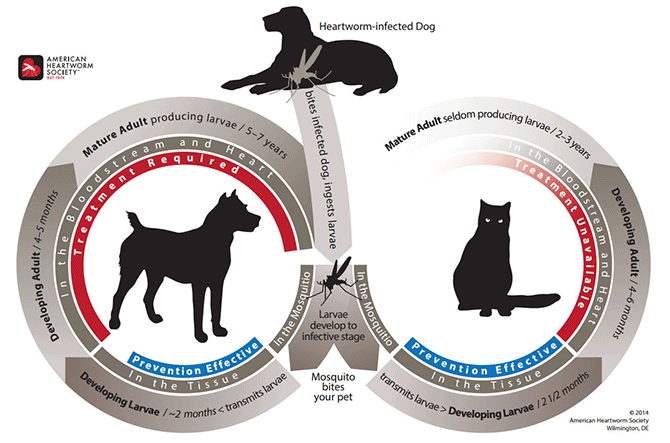What is Heartworm Disease and How Does it Spread?
Dirofilaria immitis, commonly referred to as heartworm, is a parasitic roundworm that infects a variety of mammals. Heartworm is found throughout the world and has been reported in all states in the U.S. The natural host for heartworms is dogs but heartworms may also live in cats, ferrets, and humans. Infection in dogs can lead to heartworm disease, a serious condition that may result in death. Cats are an atypical host since most worms in cats don’t survive to the adult stage. If cats become infected, however, they may develop serious health problems. Although isolated human infections have been reported, heartworm is not currently recognized as a human health problem.
Hosts for heartworm include domestic dogs, wolves, foxes, and raccoons. Heartworm is spread by mosquitoes that bite an infected host and then pass the parasite to another host during a blood meal. Aedes, Anopheles, and Mansonia species of mosquito are all capable of transmitting heartworm. Humans and other mammals are accidental hosts and cannot play a role in spreading heartworm as the worms do not produce the microfilariae necessary for transmission. Heartworms are only spread by the bite of a mosquito and cannot be passed directly from one dog to another. And people cannot get heartworms from their pets.
Signs and Symptoms of Heartworm Disease In Dogs
Common Symptoms
- It takes about seven months for the parasite to develop into an adult heartworm once a dog is bitten by an infected mosquito. Initially, dogs will show little to no symptoms.
- As infection persists, dogs may experience a persistent cough, fatigue, decreased appetite, and weight loss.
- Heavy worm burden can stop blood flow to the heart and cause a condition called caval syndrome, which leads to heart failure.
Treatment of Heartworm Disease
- Both topical and intravenous drugs exist to treat heartworms. The specific treatment plan will depend on the severity and stage of the disease.
- For dogs that develop caval syndrome, surgical removal is the only treatment option.
- Without proper treatment or surgical removal, most dogs will die from heartworm disease.
- Fortunately, there are FDA-approved products to prevent heartworms in dogs. Most are given monthly and require a veterinarian’s prescription.

Heartworms in Cats
Though cats are not as susceptible to infection as the worms don’t thrive as well in their bodies, they are still at risk for the disease. In cats, heartworms don’t live as long and rarely mature into adult worms. Signs of heartworm may be hard to detect and include coughing, wheezing, periodic vomiting, or weight loss. Unfortunately, there is no approved drug treatment for heartworm in cats and the goal is to stabilize the cat through long-term treatment. There are, however, FDA-approved products for the prevention of heartworms in cats.
Meet the Heartworm
Adult heartworms grow to 12 inches in length and have the appearance of cooked spaghetti. Heartworms have a lifespan of five to seven years and an infected dog may have anywhere from 1 to 250 worms.
Controlling Aedes, Anopheles, Culex, and Mansonia Mosquito Species and Heartworms
An Integrated Mosquito Management (IMM) program is essential to helping prevent mosquito bites and transmission of serious vector diseases to both humans and pets. As part of an effective IMM program, VDCI recommends a 4-pronged approach to target all phases of the mosquito’s life cycle.
Community understanding of how to properly eliminate mosquito breeding habitat and take personal protective measures is critical. Furthermore, distribution of educational pieces is important for treating symptoms and aids public health officials in identifying disease problem areas.
2: Surveillance
In order to understand the risk and address the threat appropriately, it is critical to determine the mosquito distribution, density, and species composition throughout the target area. Surveillance will also provide direct evidence of an increased transmission risk of a disease.
When mosquito larvae are detected in an area, trained and experienced ground crews reduce breeding habitat when possible, then preferentially apply Bacillus thuringiensis var israelensis (Bti) to remaining areas of standing water, stagnant pools, and water-holding containers. Aerial and ground application of larvicide via ULV equipment can provide control in hard to reach container habitats.
VDCI recommends the deployment of two-person teams to conduct targeted ULV applications combined with residual “barrier” applications via backpack applicators to mosquito harborage areas near homes and other structures. In addition, when the disease risk warrants it, truck and aerial ULV applications should be utilized to reduce the adult mosquito population. When combined with our larvicide efforts, these methods have proven highly effective at significantly reducing local populations of the target mosquitoes.



